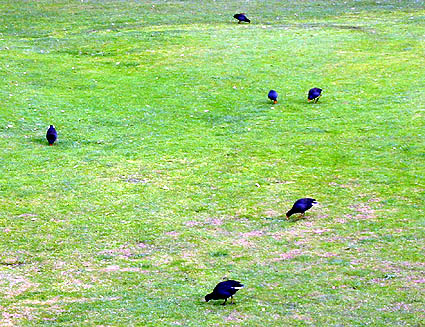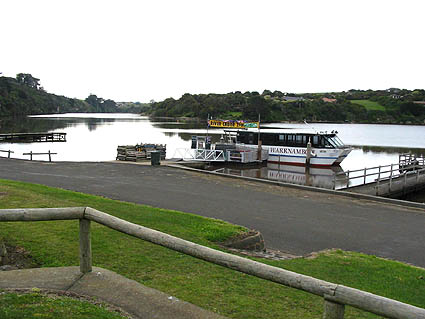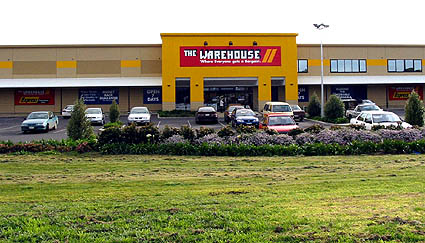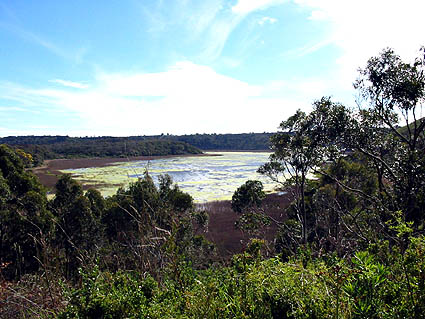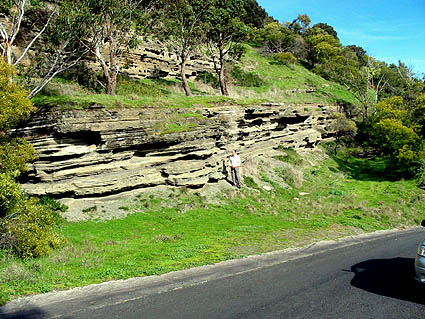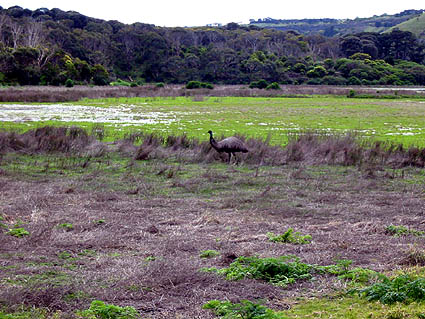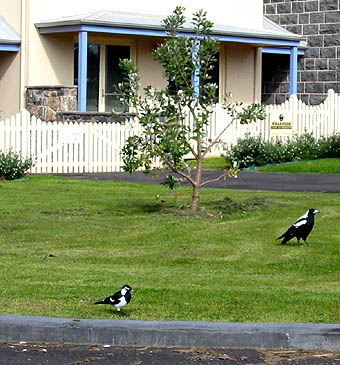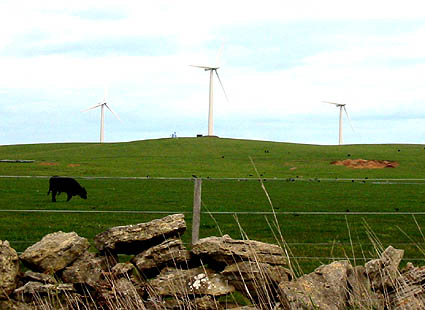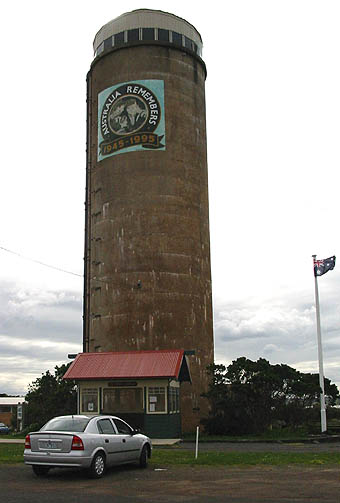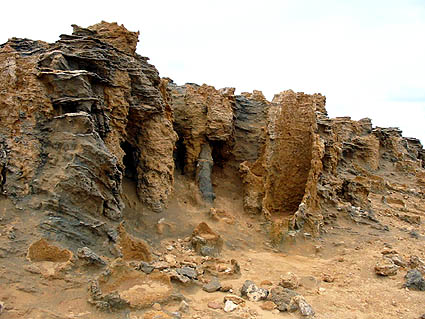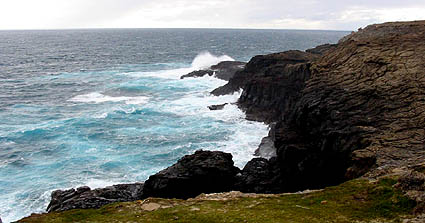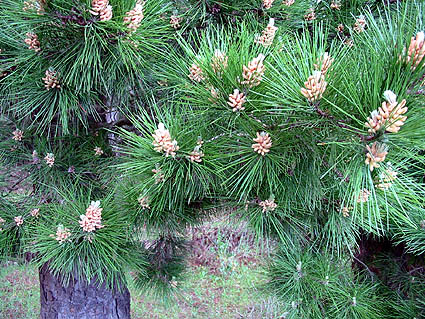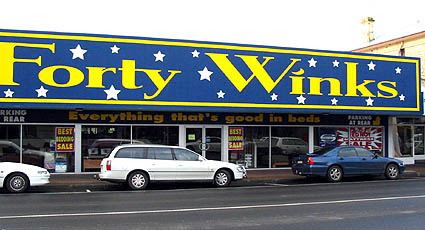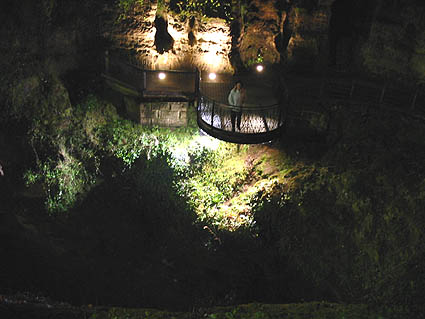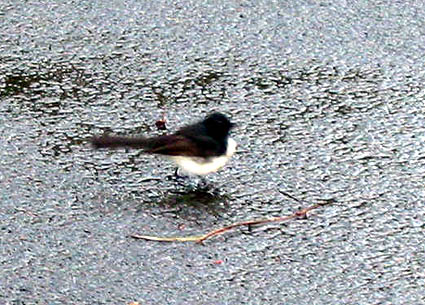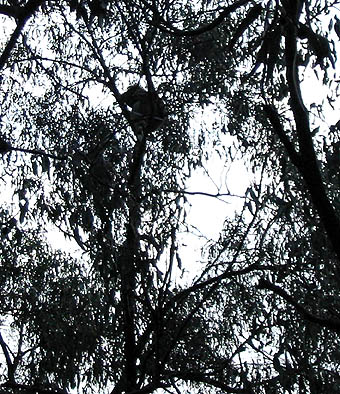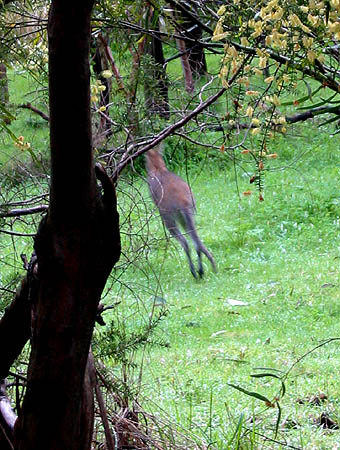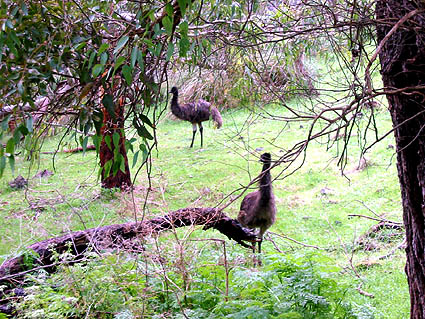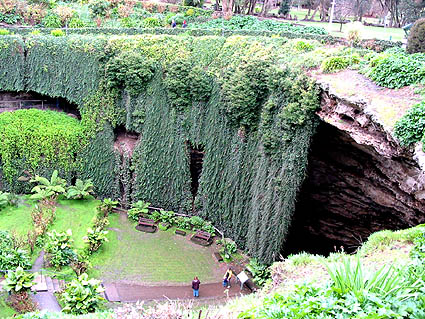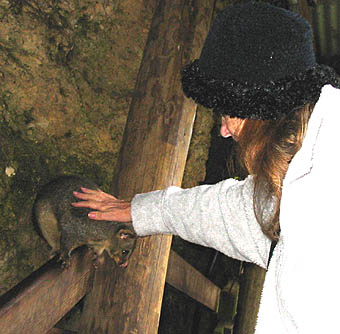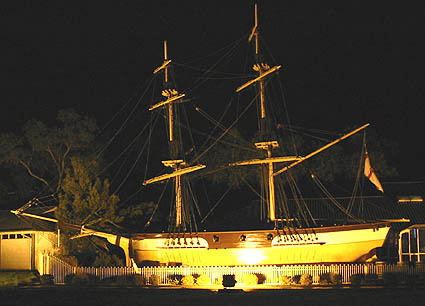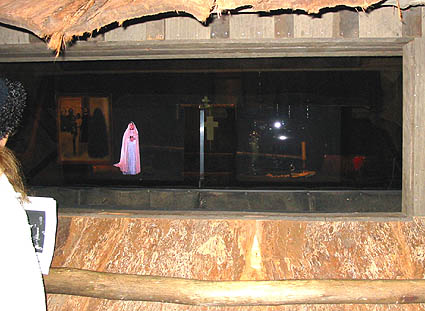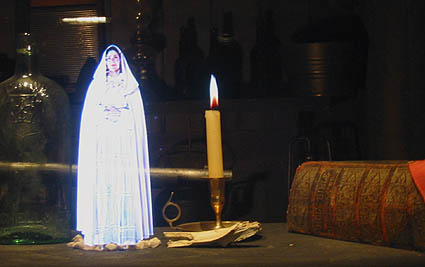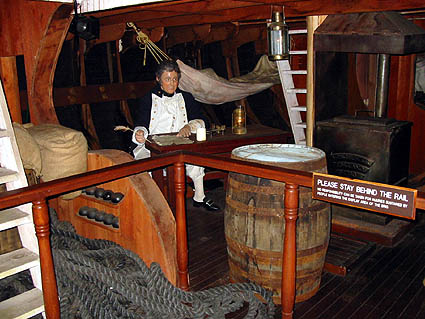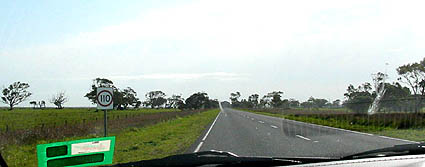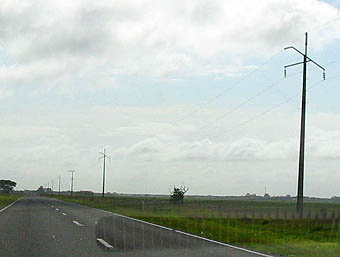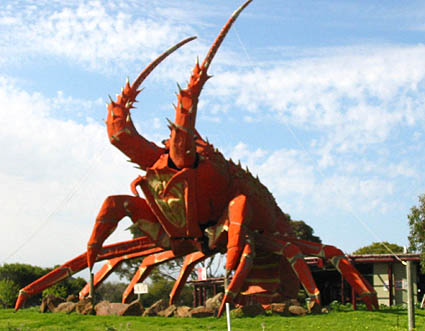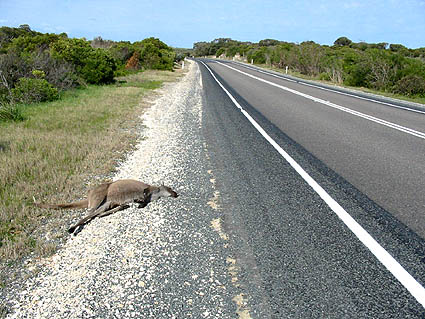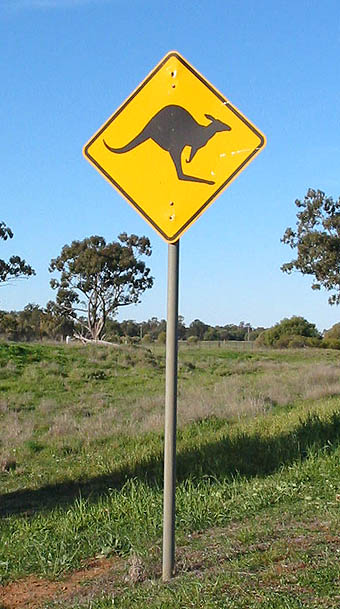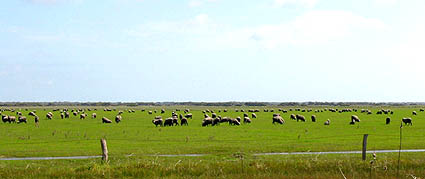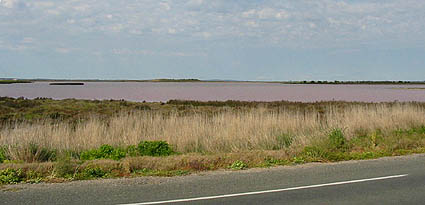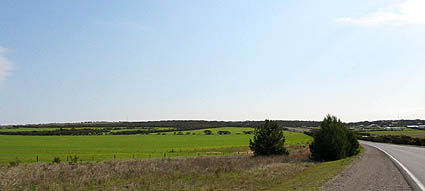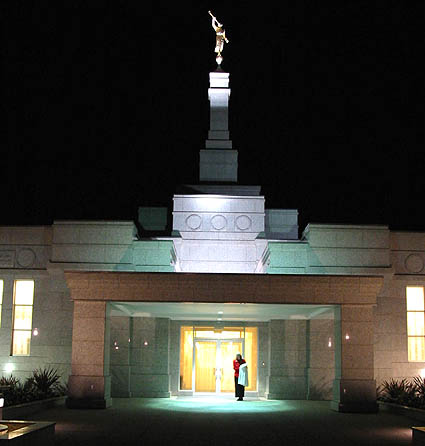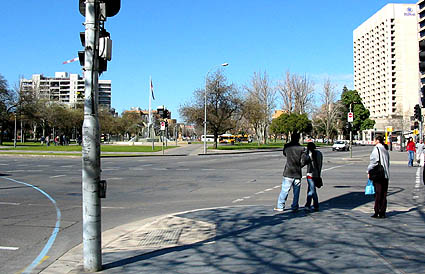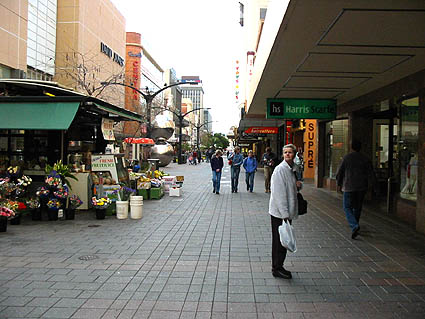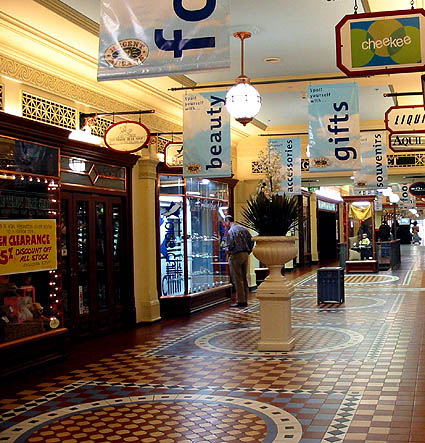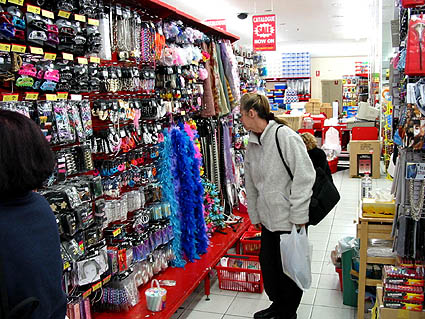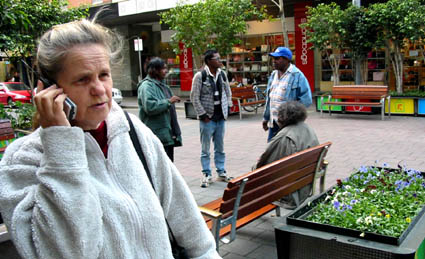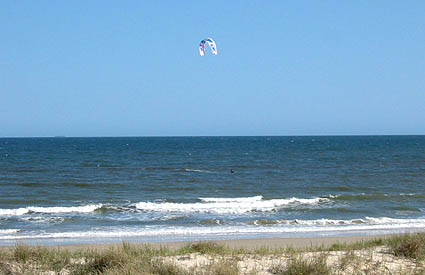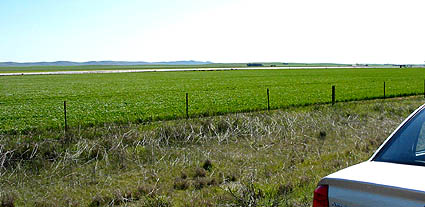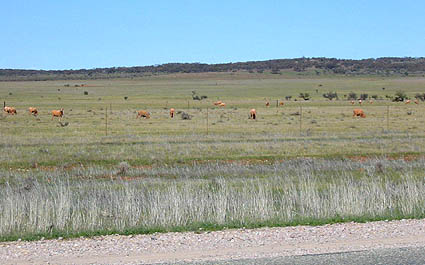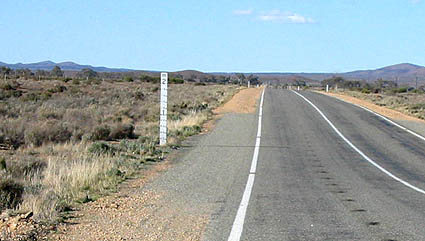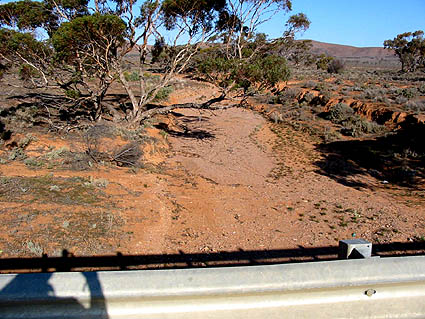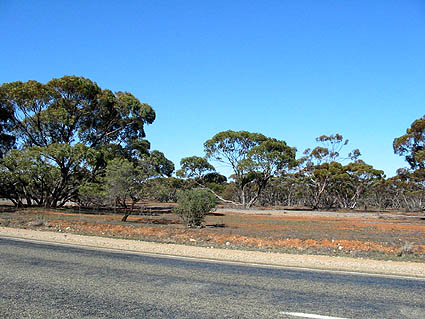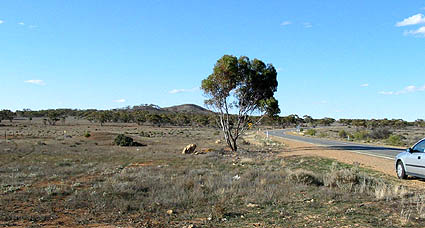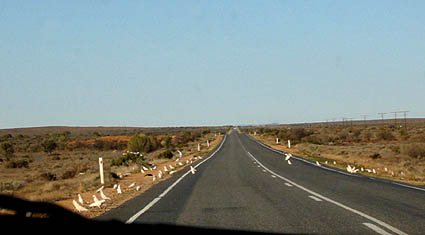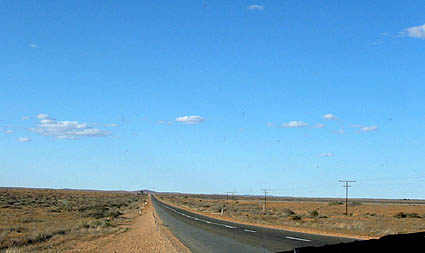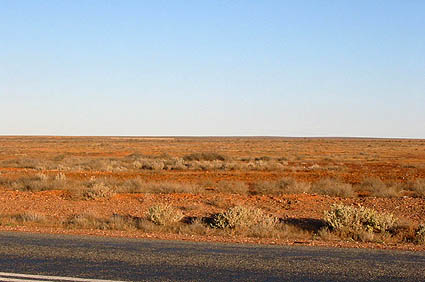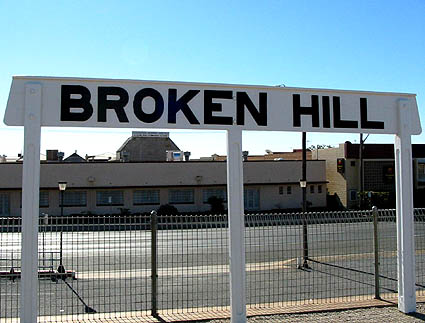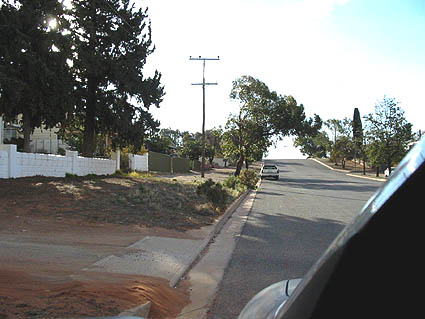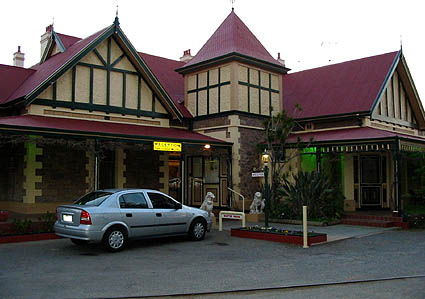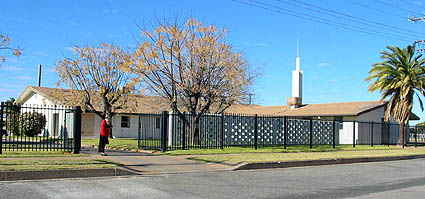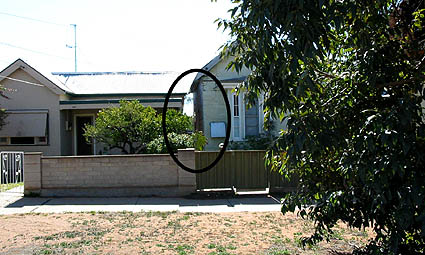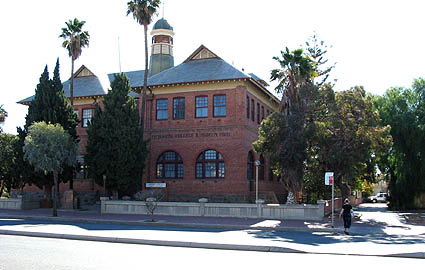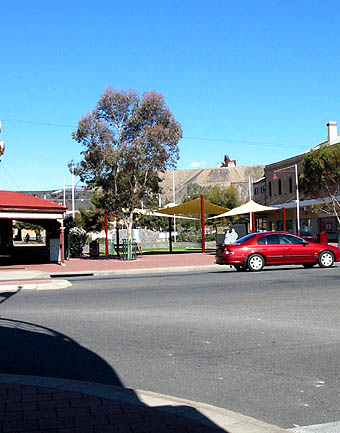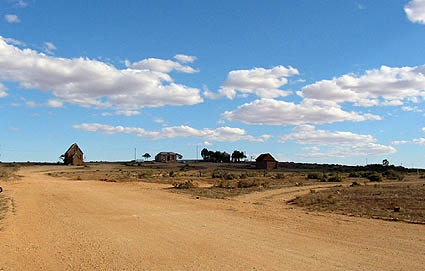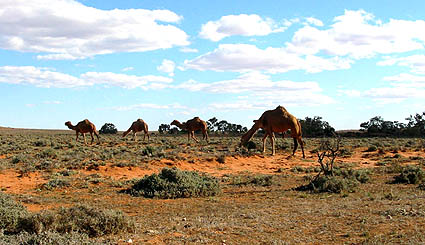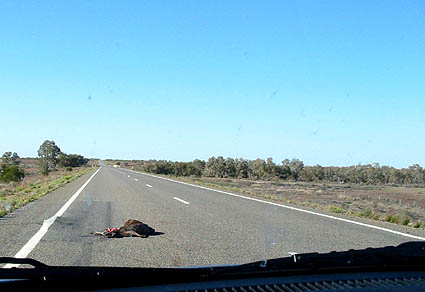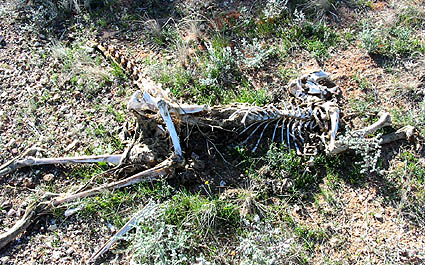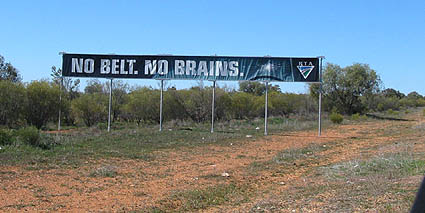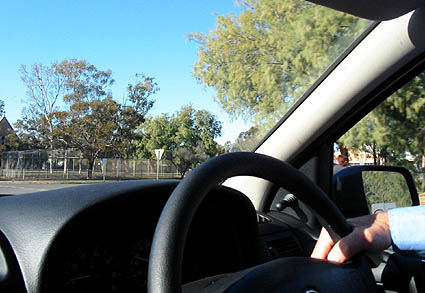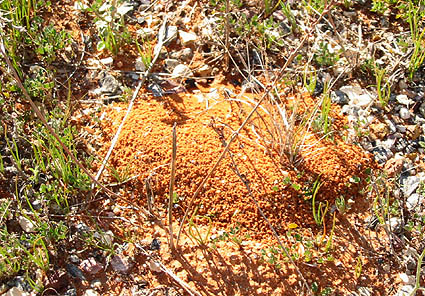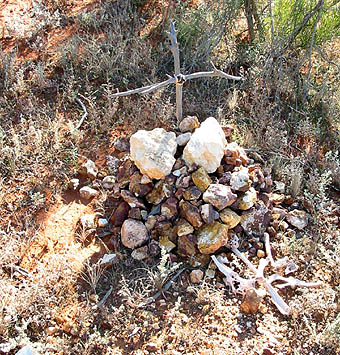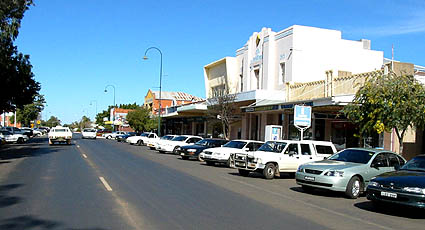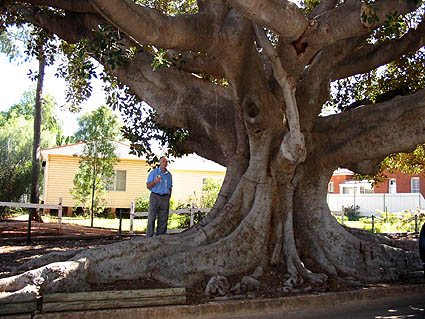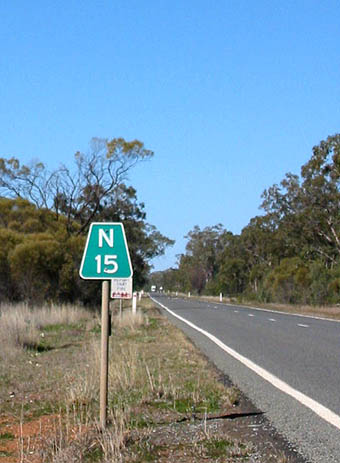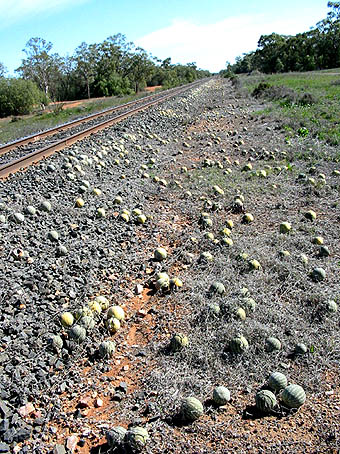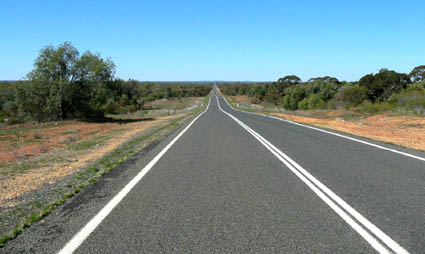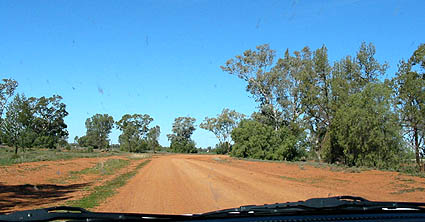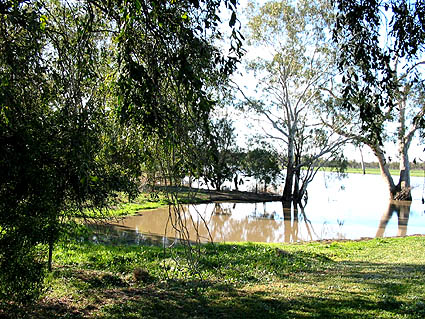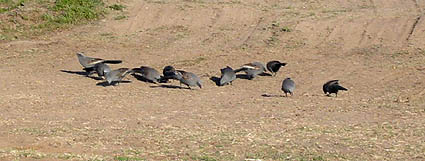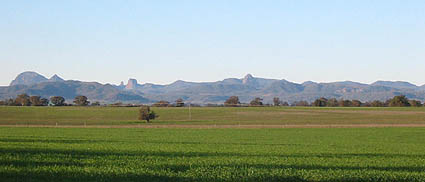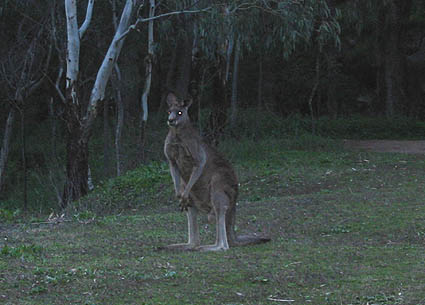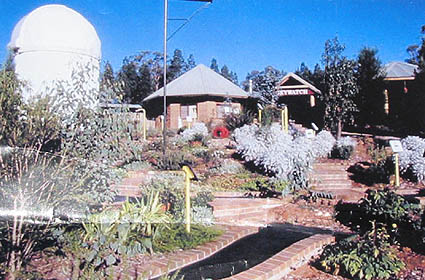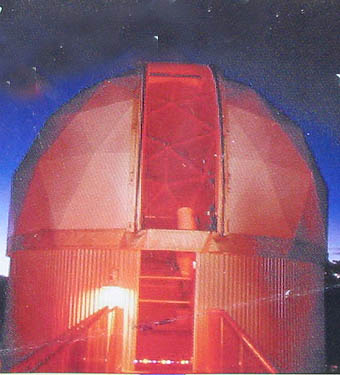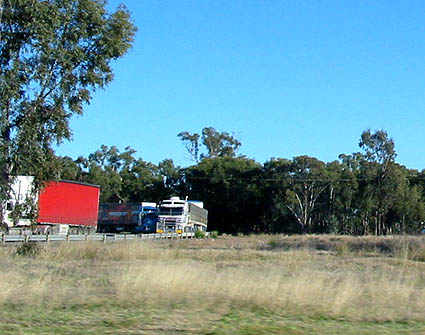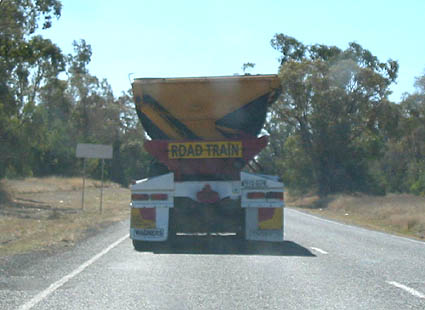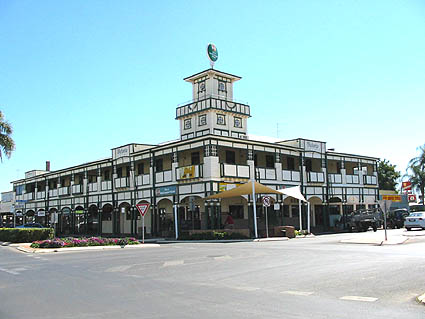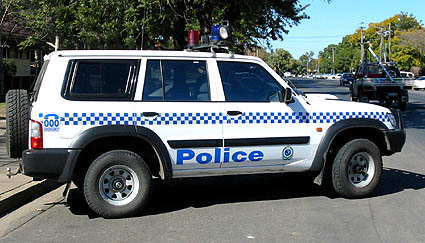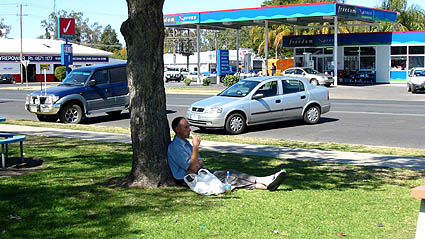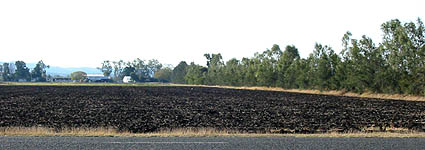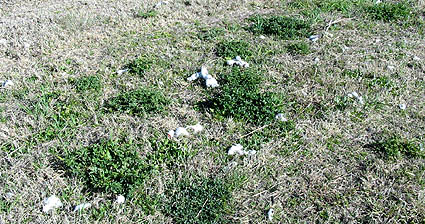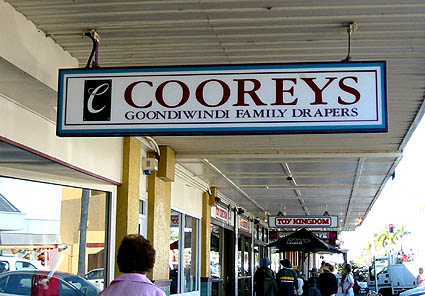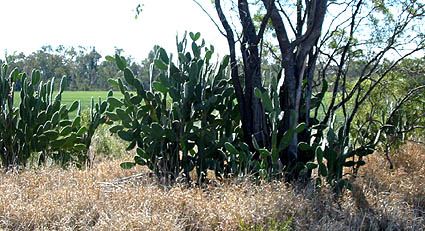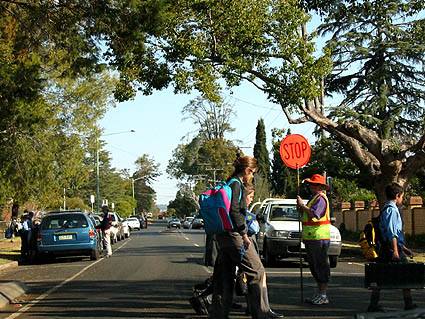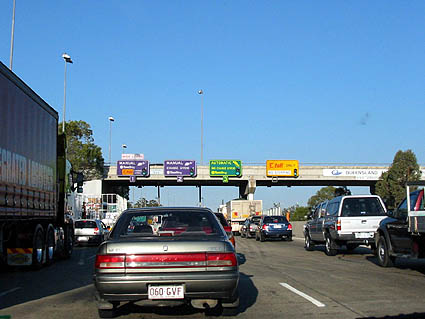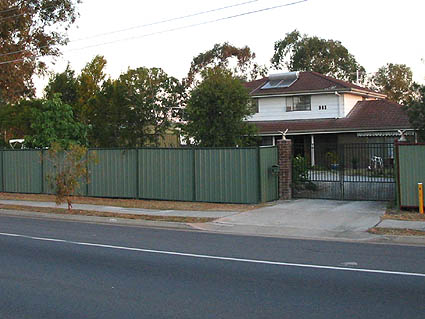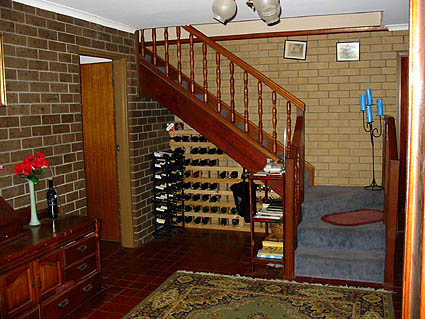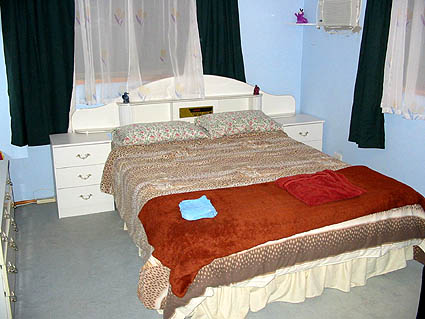|
Australian Four State Trip – August 2004
South Australia Part Two |
||
|
We stay the night at Napier-like Warrnambool We eventually arrive at Warrnambool at dusk. Warrnambool is a Napier-like town on the south coast of Victoria with a population of around 30,000. We choose a motel called City Heart Motel, just off the main road to lessen the traffic noise. Cost is $78 for the night. It’s a bit small but OK. The fragrant smell of an electric insect spray release is a bit overpowering, so I turn it off. We then walk downtown in the dark and buy some fish and chips for tea. We have to wait a long time for some reason. We take them back to the motel. The fish pieces are huge, and very tasty. The chips are nice also. Marie then had a shower and went to bed early and fell asleep instantly. She is still worried sick about "the Abos" in Wilcannia. I sit up and plan tomorrows activities and driving. I enjoy doing this. Tomorrow we cross the border into South Australia and start heading north to warmer temperatures. Exciting!
Thursday 19th August Early morning walk to the beach We both had a good sleep last night. Warm bed. Marie’s a bit better this morning, but still wants to go home. Sunny day but cool. I get up early and go for a walk through the town to the beach. The few passerbys I see avoid my eyes and do not seem very outgoing. I see some Pukekos which surprise me. I thought they were native to NZ.
Pukekos, at least that's what they look like.
The beach has brown sand with lots of grass stalks and seaweed. Cold wind. The river mouth is quite beautiful. The only clear water river I have ever seen in Australia.
Warrnambool River mouth. Clear water.
We visit the Warehouse and Spotlight Marie and I visit the local Warehouse later this morning. Almost empty. Nobody at the single checkout counter but us. Prices are cheap. The shop assistant is friendly as always, but the Australian female nasal strine is beginning to grate on my ears a bit. No music to it.
OZ Warehouses are painted yellow instead of red.
The I then let Marie go and shop at Spotlight while I wait in the car. Spotlight is the most boring shop in the world to me. I can't find one item of interest in the whole shop. I eat a NZ kiwifruit (3 for $2) and a Grannysmith apple. The OZ Grannysmiths are very tasty when you get a good one.
I improve the car’s bumpy ride We then fill up with gas, $1 a litre, cheapest yet, $37 for ¾ tank . Not as many gas stations in OZ as in NZ. Because some of the roads are very bumpy I decide to lower the tyre pressure in the rental car. The tyres are all at 34 psi. The recommendation is 32 psi front, 27 psi rear. I lower the front to 30 and the back to 26. The car now rides much better. It has Pirelli P3000 tyres which are noted for good handling and ride but are rather noisy. We leave Warrnambool and set off again on the coastal highway toward Adelaide. I mention to Marie that I’ve not seen one travel agency in OZ so far. She can’t remember seeing one either.
The volcano crater wildlife sanctuary After about 15 kms we turn off to visit a large extinct volcano crater that has been converted into a wildlife sanctuary. We drive up the rim and then down inside the crater.
Volcano crater reserve from distance.
The inside walls are ribbed limestone. I stop and have a close look. The centre of the crater is a big swampy lake and the rest a mix of grassland and forest with the road winding all over the place. There is also a small but high hill in there, like a small version of Mount Maunganui.
Crater walls, ribbed limestone.
There are lots of birds down inside and we see two wild emus out in the swamp area. We park on the grassy roadside and I walk down through the forest to the swamp edge, hoping to see a snake on the way, but no luck. I see some more emus. Marie didn't want to get out of the car.
Wild emu in the crater swampy centre.
We then drive on to the circular Visitor’s Centre, park under the trees and tour the building. Lots of Aboriginal art on display and for sale. Quite a striking high gloss desktop made from a huge native tree. We meet a chatty guide who is also named Marie. I wanted us to climb the hill before we left, but not unexpectedly Marie dismissed the idea. The tower at Portland. Later this morning we come to Port Fairy, a fishing town. Quite picturesque as we drive around the river mouth area. Marie sees two different black and white birds on a lawn.
A magpie and unidentified bird.
Then on to Portland. This is a windy area of the South coast and there are windmills on the coastal hilltops, like the ones on the Palmerston North hills.
Windmills along the windy coast around Portland.
I go to climb up an old tower at Portland, just like the one on Drury Hill at Wanganui, but the cost is $4. I think it's a bit steep. But Marie insists I do it and pays the $4. The friendly old codger who looks after the tower lends me his binoculars. The tower has an inside circular staircase (124 steps) and old war photos on each of the five landings.
Tower at Portland.
From the top, through the binoculars I see many windmills around the harbour and also an aluminium smelter. I would have liked to have toured the smelter but the old fellow tells me there are no tours on Thursdays. We also visit a model railway display, which Marie likes, and which also has a small car museum.
The Petrified Forest and blowhole We then take a detour out to the rugged coast to see the Petrified Forest and Blowhole. When we arrive there is a strong, buffeting, cold southerly wind blowing off the sea. Marie stays in the car while I walk the track over the limestone rocks down to the Petrified Forest, about 200 metres. I am a bit disappointed. The formations don’t look much like trees at all, too close together. I have never seen a forest with large trees that close, only inches from each other. There would be no room for the roots.They look more like old stalagmites. So does the texture of the rock. Although they do appear to be hollow which I don't think stalagmites are. I take a broken chunk, and put it in my pocket.
The Petrified Forest.
I then walk about 400 metres in the other direction to see the blowhole. It wasn’t working, but the boiling sea was a vivid shade of turquoise blue. Very attractive.
Unusually blue boiling sea at blowhole.
It was lovely, finally, to get back into the warmth of the car. What a chilling wind. I show Marie the rock sample.
Pine tree pollen flowers There are lots of pine tree plantations in this area. At this time of the year just like in many parts of NZ, everything gets covered in yellow pollen. We stopped alongside one plantation and I inspected the flowers that grow on the trees and shed the pollen. By flicking the flowers with your finger you can produce yellow clouds of pollen that float into the air.
Pine tree pollen flowers.
We stay the night in Mount Gambia It's a long drive to the next main town Mount Gambia. Still on the coast. Mount Gambia is a pleasant tourist town of about 40,000 people. It's built on limestone. Lots of caves and sink holes. Sink holes are places where the ground has collapsed into an underground limestone cave. One local Aussie later likened Mt Gambia to the Tauranga of Australia. While Marie is doing some shopping, I visit a huge, well presented bedding shop called 'Forty Winks' which I think is a quite cool name for a bed shop. The sign is cool also. We have just bought a new bed and I was surprised to see the same beds on sale here as we saw in NZ. I tell the girl that we have just bought a latex rubber mattress. She said her boss also has one. I asked her if he had ever said he found it hot in the summer, (ours is so warm in winter I suspect it may be too hot in summer). She said yes, but he solved that by putting a pure cotton underlay on top. She takes me and shows me one. It's about an inch thick, soft, cool and luxurious and cost $98. If it wasn’t so bulky I would have bought one, but they should be available in NZ.
The bed shop. Cool name and sign.
As it's getting late and there seems to be a lot to see here, we decide to stay the night. So Marie books us in at the Blue Lake Motel, an large, older motel complex, but away from the traffic noise. Vegetarian burger for tea We have tea at Hungry Jacks. I have a vegetarian burger which seems better tasting than a meat one. It has a lentil pattie type of filling with cheese and onion and brown tomato sauce. Very tasty! However the 40c ice cream didn’t taste as good as the one Patricia bought me in Melbourne. Hungry Jacks is similar to Burgher King in NZ. After tea we visit a floodlit sink hole in the heart of the town. It occurred many years ago and has a natural waterfall inside of it.
The sinkhole at night. Bit hard to make sense of this photo, but that's Marie standing on a viewing platform halfway down the hole.
We then do some grocery shopping in a supermarket, which looked identical to a NZ supermarket. No noisy hoons in their cars so far in OZ. Yet they are everywhere in Tauranga and the Mount, also in Whangarei I noticed earlier this year. Our motel might be away from the traffic noise, but it has a noisy airconditioner/heater and also a noisy fridge which starts every few minutes. I switch the fridge off before going to bed. It has a hard bed also.
Friday 20 August
We both slept well last night despite the hard bed. I awake early about 5 am and read my scriptures. This always starts my day off right. Reminds me of eternal principles, otherwise it is too easy to become worldly. Blue Lake and wildlife sanctuary I then drive out alone at sunrise to the Blue Lake for which Mt Gambia is famous. This lake is surrounded by hills and turns a bright vivid blue in the summertime, due to an organism that alters the mineral content of the water. This allows more of the blue part of sunlight to be reflected. Rotorua has a similar lake. However the lake is a drab grey blue this time of the year.
The Blue Lake at Mt Gambia
There is a fenced-in, wildlife sanctuary on the shores of the lake, so after going for a short run along one of the hillside tracks I drive down to the sanctuary and park outside. As I get out of the car I see a fantail on the car park bitumen. I didn’t think they had these in OZ. It is a darker brown on top than the NZ birds, almost black. So I took a photo.
Australian fantail. Darker on top than the NZ one.
I have to pass through two sets of gates to get into the sanctuary. I seem to be the only person there and it is very peaceful and still. I soon have to walk over a boardwalk across a lagoon. It is covered in wet duck poo and is extremely slippery. I have to be careful not to slip into the murky dark brown water which is only about two inches below. There are many large trees in the sanctuary and sometimes walkways up to viewing platforms in the tree’s canopy. I see a koala bear in one of the trees and take a photo.
Can you see the Koala bear up in the tree?
As I walk further along the winding criss-crossing paths, kangaroos and wallabies bound away from me. Big kangaroos are surprisingly graceful in their leaps. You can sense the effortless power in their hind legs.
Kangaroos keep leaping away as I approach.
I also see emus here and there. They seem quite tame. I still don’t see any snakes. Must have walked about 3 kms.
The emus are much tamer.
The Unglbrecht sink hole When I get back to the motel, we pack the car and drive down the road to the largest and most famous sink hole in the town, called the Unglbrecht. Nice lady (Kathy) in the visitor’s centre. This sink hole has hanging gardens planted down the sides and looks a real picture in springtime judging from a photo in the visitor’s centre). Even now in wintertime it is still impressive.
The Unglbrecht sink hole
Possums come out to be fed at night time. Bit as Marie walks down the stairs inside the sink hole, a possum comes out to see her in daylight, so she patted it. She said it was very soft. If you tried to do that with a wild one you would immediately get savagely bitten and torn by its claws. I’ve seen it first hand.
Marie patting the tame possum.
The Natural History Museum and hologram display Then Marie and I drive to the famous local museum of natural history that has a full size replica of an old sailing ship outside. We saw it last night and took a photo. Quite impressive and a major tourist attraction.
Full size replica of an old sailing ship
While touring the Museum we see a show that becomes a highlight of our holiday. It is a hologram of a 19th century Australian missionary woman named Christina. The show starts from an old sepia-toned group photograph in which Christina is standing. Then her image in the picture begins to glow and she starts to speak, and relates her traumatic experiences among the Aborigines. I am thinking "this is quite impressive," when she actually steps out of the photo, as a miniature living person, (a hologram) still speaking and lights a fire, and then she lights a candle.
Christina walking out of the photo. Really cool!
Finally she finishes her story and then walks back into the photo. Very realistic and well done. Just like a real ghost, but done using laser holography.
The candle flame is also a hologram.
After the show we inspect the interior of the sailing ship. It is crammed with provisions, and dark and gloomy below deck. Hardly any room to move. Conditions must have been hell in those days. There is a live narration by the captain.
Interior of sailing ship. Cluttered and dark below deck.
Inland across to Adelaide We now leave Mount Gambia and head inland to drive across to Adelaide. We drive for hours through green farmland. Some nice pastoral scenery. Fewer gum trees. 110 kph speed limit and long straight roads.
110 kph speed limit and long straight roads.
About mid-day the roads become very bumpy at speed. Marie starts to complain about a sore back. Unusual three prong lamp posts.
Three prong lamp posts.
We stop for lunch in a sleepy little country town called Kingston. Marie manages to find a friendly food shop that makes us two huge wholemeal filled rolls for $3 each. They taste a bit bland at first without salt, but Marie finds a little sachet of salt in her purse. Later I was to eat half of Marie's roll for tea. I think I am eating too much. Kingston has a huge lobster on the roadside. Absolutely massive. it is a real work of art, very well done.
Compare the size of the building behind. Very realistic.
We set off again and soon come across our first dead kangaroo on the road. This was to become a common site in the interior. Even more common than dead possums on NZ roads.
Our first dead kangaroo. Another 150 to go.
These signs are all over OZ.
Long-legged brown sheep and yellow-green water We drive all afternoon. Although the farmlands are green, many things are quite different from NZ. The sheep are not white, but brown, and sometimes grey, and they have long legs, probably Merinos.
Brown, long-legged sheep.
The few rivers we cross have yellow-green water and look sluggish. We also pass a pink lake, something to do with algae in the water. I stop and take a photo.
Pink lake due to algae in the water.
Not a lot of traffic on the road. There is another, evidently boring inland route from Melbourne to Adelaide, but we are taking the older slower coastal route. Steadily getting milder. Steep descent into Adelaide Soon we near Adelaide and intersect with the main inland route. The highway quality immediately improves and becomes four lanes, smooth and wide, but much busier. There are bright green newly planted wheat fields all around. Looks quite beautiful.
Bright green wheat fields near Adelaide.
Soon the road becomes six lanes wide and we begin a long, very steep descent down into Adelaide. I had no idea we were so high up. Its like going down the Ngaranga Gorge into Wellington, but about four times longer. There are many runaway ramps for trucks. I want to stop and take a picture, but the traffic is heavy and moving fast and Marie is feeling a bit stressed. We finally get to the bottom and drive into Adelaide about 5pm, during rush hour traffic . We find the Temple and a motel The streets are quite narrow in Adelaide, with lots of trees. We first of all locate the Temple on the far north of the city, about 30 minutes drive through busy traffic. Adelaide is more compact than the other big OZ cities but still huge. We find the Temple and ask what time the evening session starts, and if there's a motel close by. Nobody knows of a motel, nor had we noticed one yet. A lady thinks there is one back up the road we had come along. So we drive back for miles, almost to the point where we had entered the city and finally find a motel, a large complex. Marie gets us a quiet back unit as it is a noisy road. The bed is hard but it only costs us $60 for the night. Marie is stressed with the heavy traffic and her fears of Wilcannia Aboriginal town and wants to fly direct to Brisbane. Tea and then back to the Temple at night We have tea in the motel, baked beans and leftovers. I have to heat the beans in hot water poured into the sink from the electric jug. Marie is not hungry. We then drive out to the Temple. It is dark and the traffic has died down by now. The Temple looks lovely lit up at night. It is also beautiful and elegant inside, but small compared to the New Zealand Temple. It feels like a spiritual oasis in the Temple compared to the materialistic OZ world outside. Friendly people. I meet the father of Quentin, the son-in-law of some NZ friends of ours. The father is a huge Australian, about 6’ 7" tall and would weigh well over a 100 kgs. Marie enjoys our evening in the Temple and says that she feels very peaceful.
Marie coming out of the Adelaide Temple at night.
Saturday 21 August Morning walk We had a restless night. The bed was hard and we woke up cold during the night and had to put on more blankets. As a result Marie is still feeling negative this morning. She still wants to fly to Brisbane and avoid Wilcannia. I try to reason with her but don't make much impression. I have a shower then go for a walk to get my bearings. Cloudy day. I walk past some fine old mansions in the area. I notice many of the houses have a tough, woven, dark brown brush for a front fence. Rather like we use pongas.
Shopping in the city centre We drive into the city centre for some shopping and park in the huge open centre rectangle that is the centre of Adelaide, rather like the Palmerston North Square but elongated and three times as long.
The city centre square of Adelaide
We then walk up and down a Mall for about two hours that is filled with (at least to Marie) hundreds of fascinating little shops, especially down side malls running off the main one. I buy a pair of soft leather belts.
The main shopping mall in downtown Adelaide.
Side malls. Some were quite elegant.
Marie shopping. This was a common sight on our trip.
While we were walking in the main Mall, Marie receives a phone call from Teresa, just as we walk pass a group of half drunken Abo men and women in a rest area. A coarse, loud, plump Abo woman, sitting on a park bench, is swigging booze from a bottle. Marie stops to speak on the cell phone right alongside, but luckily doesn’t notice them. I sneak a photo of them while she is talking.
Aboriginal group in Adelaide Mall.
Soon after this, Marie finds a chocolate shop and encounters a rude shop assistant, the only one on our holiday. I found the chocolatey sugary smell of the shop overpowering, so I was waiting outside. She came out rather upset.
Off to the outback and Broken Hill We then drive out to the windy Adelaide beach and watch some kite surfers for a while.
Kite surfer at Adelaide beach.
Then it is time to leave the city and head for the outback, to Broken Hill, a six hour drive and 700 kms. It is 16°C in Adelaide as we leave. I am excited but Marie is fearful. Interesting countryside What an interesting drive. We soon leave the clouds behind us and have a pale blue sky from horizon to horizon and long straight roads. The crop lands near the coast are still bright green with newly sown wheat or bright yellow with Canola, but after driving an hour these too are mostly left behind. The countryside becomes brown sheep farmland with orange soil starting to show here and there, and stunted gum trees. However large water pipes are sometimes seen, stretching for miles into the distance, with bright green crop fields either side.
Irrigation pipes produce green crops on dry land.
Into the warm deserted desert The temperature is steadily climbing, 17° 18° 19° 20° 21°. We have the road to ourselves. Traffic is almost non-existent except for an occasional truck. The grass is still green here and there, but more often brown or grey, and more and more bare orange soil is showing. Even the sheep have orange wool.
The soil is orange and so are the sheep.
There are occasional dips in the road to allow floodwaters to disperse. These dips have white measuring poles on the roadside with marks graduated up to two metres to indicate water depth.
Flood depth marker in flood-dispersing hollows of the road.
I cure the car’s bumpy ride Marie seems happier now all of a sudden. (She later told me that it was after a silent prayer to dispel her fear.) However the road is starting to get bumpy again. So to save Marie’s back, I stop and let all four tyres down for a 5 second hiss of air. They still don’t look flat, but it makes a huge improvement to the ride, and doesn’t seem to affect the steering or performance. (I leave them at this lower pressure for the rest of the trip.) Dead kangaroos Lots of dead kangaroos, even though the highway is fenced on both sides, about 50 metres out from the road. I suppose big kangaroos can easily leap the fence. It’s probably only there to keep the sheep off the road. I have been noticing constant dark patches on the road. Then I suddenly realise that it must be dried kangaroo blood. I have seen that they bleed a lot when hit. We are now well into the desert outback. No more crop fields. Still the occasional orange or brown sheep to be seen amongst the scrub. No water anywhere, only dry wadis which the Ozzies call billabongs.
A bilabong (or dry river bed) These are all bridged, but not a drop of water in any.
Stimulating desert scenery The countryside is becoming quite colourful, with many shades of dark green, brown, grey and orange. The sky is a perfect blue and not a cloud anywhere. The horizon is flat in all directions. An artist’s dream. The feeling of freedom is intense. I get the impression you could walk in any direction for a week and it would still look the same. Millions of stunted grey-green trees and shrubs, grey, straw-like grass, and bare orange soil. I want to stop and go for a walk but Marie is afraid I’ll get lost if I lose sight of the road and she will be left alone. It would be easy to get lost without the sun to provide a sense of direction.
I feel like exploring. This scenery extends hundreds of miles in all directions.
Flies drive me back to the car We stop at a billabong to get a photo. Despite Marie’s protests I can’t resist going for a small walk. I don’t go very far however before annoying darting little flies find me and hover round my eyes. I wave them away but they are persistent. I finally get fed up with them and go back to the car. Marie is relieved. She probably prayed for something like that to happen so I wouldn’t be too long. The flies were never again that annoying when we stopped, only the odd one or two.
Where the flies attacked me while out walking.
Small settlements every 100 kms About every 100 kms there is a small settlement, usually just a truck stop, gas station, and 5 to 10 run down old houses. By mid-afternoon the temperature has reached 24°. But we don’t need the air conditioning on, probably because of the low humidity. We are now well and truly in the desert. Not even any trees in sight, just scrub, orange earth, lamp posts following the road, and a beautiful huge blue sky. We come across a flock of dove-like white birds on the road. They seem to be eating something, perhaps ants.
White doves in the desert road.
About this point we cross the SA border into NSW. No road stop, just a sign.
Almost pure desert.
The real thing. I feel like hiking out there for a day.
We arrive at Broken Hill As we drive into Broken Hill at sunset, the temperature is 22°. After hours of desert scenery, Broken Hill looks surreal, with the setting sunlight reflecting off the large gum trees lining the streets.
Broken hill railway station.
Nearly all the houses in Broken Hill are very old, even older than the ones in Wellington. Some are sited extremely close together. The streets are very wide and the gutters twice as high as normal. It is also quite hilly. Lawns are bare dry soil, or brown grass and thistles. Many are overgrown but some are green. Driveways are mostly just orange dirt. The town does not look prosperous.
Barren or overgrown lawns.
Fran’s motel We find a motel that was once an elegant doctor’s house, built 1910. Fran, a pleasant, no-nonsense down-to-earth outback type lady runs it. She tells us she still remembers a wonderful holiday she had in lush green Rotorua, and would love to go back there again and live.
Fran's Broken Hill motel.
Marie seems to have at last settled down about Wilcannia, much to my relief, but then she makes the mistake of asking Fran the motel lady about Wilcannia. I think she was expecting to hear some reassurance. But Fran's opinion of the town was along the same lines of my cousin Gerard, and resurrected her fears all over again. I could have throttled Fran. After unloading the car we drive out into the warm night and locate the LDS Chapel for church tomorrow, and then we buy some more vegetarian hamburgers from a takeaway food place. Very tasty again. We then gas up ready for an early start on Monday morning, when we have to pass through Wilcannia. We have done over 2000 kms since leaving Melbourne. Gas is costing us about $37 per 500 kms.
Sunday 22 August Church in the morning We slept well last night. Nice soft bed. Mild night. We are told that Broken Hill is warmer than normal for this time of year, and also drier, as we attend church at the local LDS branch. About 75 members are present. Friendly people. The children give a musical presentation for Sacrament Meeting. There were some mischievous boys among the group. Spirituality seems a little lower than normal among the members. The Branch President, President Judge is a young mining geologist. It was interesting to talk to him afterward.
The Broken Hill LDS chapel, the same everywhere.
Walking around Broken Hill We eat lunch back at the motel and then walk around the township, still trying to keep the spirit of the Sabbath Day. Broken Hill has a population of about 25,000. The city seems to attract a large number of arty crafty people, much like Waihi in the Bay of Plenty does. Apart from size, Broken Hill and Waihi are similar towns in many ways. Most of the suburban houses look to be about 1900 vintage. Some of them are so close you can barely walk between them. Nearly every house could be empty for all the signs of life we saw. Few children can be seen, except in a park we walked through.
Some Broken Hill houses are built less than a metre apart.
In the downtown area we see several art galleries, all closed except one which we toured. It seems apparent that the surrounding desert scenery, blue sky, and orange soil is popular with artists. Prices for the paintings were steep, at least in this gallery.
There are some nice downtown buildings.
As we carry on walking downtown and I am amazed to see a huge towering slag heap, just across the railway line in the centre of town. It is higher than the highest building and has what looks like a mining office built on top of it.
Huge slag heap visible downtown.
Silverton ‘ghost town’ We then walk back to the motel and drive out into the desert to a nearby ‘ghost town’ called Silverton. I was disappointed however. Just a few scattered old mining town buildings converted to tourist shops. However the orange soil and blue sky colour contrast is striking.
Ghost town of Silverton. You can see why artists love this area.
We also see a herd of camels crossing the road from a camel trekking company.
Camel herd near Silverton.
When we get back into Broken Hill we drive around the whole city. Quite a spacious city, but rather unkempt houses.
Second night in Broken Hill We are staying in Fran’s motel again tonight. We have lukewarm baked beans and leftovers for tea. These 3 star OZ motels have no cooking facilities except for tea and coffee making. Marie makes some phone calls to various relatives tonight. Two long drives ahead of us tomorrow (Monday) and the next day. Both about 900 kms, the distance from Tauranga to Palmerston and back again, but much quicker to traverse. You can often stay at 120 kph for virtually a whole hour. We drive through Wilcannia tomorrow. Marie is on edge about it. I still cannot understand why she should be concerned. I would love to stop and tour the town. It sounds highly interesting and very different. I have observed that Aborigines are a very social people. They tend to congregate outdoors instead of being shut up indoors like Europeans. They may pilfer, but they do not appear to be violent by nature.
Monday 23 August We leave Broken Hill We arise early and leave Broken Hill at 6-30 am. Cool morning, only 9° but still dry with no dew on the grass or cars. The sun soon rises across the desert. Another beautiful clear day. The solitude and colours of the desert surround us and I am again highly stimulated. Numerous dead kangaroos on the road. Marie sees a truck collecting them. Marie has now decided to keep a daily journal also, and is making a count of dead kangaroos. (She will get to 40 today.)
Freshly killed kangaroo, but not by us.
Not all get picked up. "Dust thou art and unto dust shalt thou return."
Wilcannia, Marie’s prayer answered In our prayers this morning Marie prayed that all would go well with Wilcannia. About 50 kms before the town we start to notice lots of rubbish on both sides of the road, cans, bottles, wrappers. plastic bags, etc.
Roadside garbage on the way to Wilcannia. Get's much worse.
Not far from Wilcannia I am doing about 120 kmh when suddenly a 4 WD police patrol passes us from behind. I didn’t even see it coming. As it disappears into the distance, Marie suspects they are going to Wilcannia. She is right. As we drive into the town it seems as if half the 600 inhabitants are out in the main road. There are aborigines everywhere, walking and talking. Some of the teenagers look quite sleek and tall. The police patrol has stopped outside what looks like a pub in the centre of town, and the two policemen are talking to a group of about 20 Aborigines. Just as we drive slowly past, the whole group of 20 turn and stroll across the road in front of us and to the sides of us. The all look cheerful and happy. We have to stop to let them past. A golden photo opportunity. But Marie is so nervous she muffs it and doesn’t even get one Aborigine in the photo.
Wilcannia, about 20 aborigines all around us and not one in the photo.
I still want to drive around the town but Marie just wants to get out of there, so we carry on. The town is probably only a km long and is sited on the banks of the sluggish Darling river. Everywhere we look the people are outdoors walking and talking. Lots of signs of life. Quite different from Broken Hill. The men look big, trim and strapping, mostly around 6 ft tall. The women look plump and dumpy. Ant’s nest and kangaroo grave We drive on for hours. The temperature has now risen to 21.5°. I stop on the side of the desert to let Marie have her first drive. Immediately I see an orange mound of powered dirt, swarming with huge blue ants, each about a cm long. Obviously a nest. As I was wearing jandals I didn’t stay around for long, but did take a photo. However in my anxiety to avoid being bitten, I forgot to activate the close-up button and the picture is out of focus, so you can’t see the blue ants.
Ants nest.
At the same spot I also see a kangaroo grave made of stones. Probably a travelling family accidently killed one and the children insisted on burying it. I could see it was a kangaroo as its tail skeleton protruded out. I took a photo of this also, which was our last. Both camera cards are now full.
Kangaroo grave.
Cobar At the next town of Cobar we stop for lunch, gas up. We also take our two camera cards into a computer shop and ask the man to put the photos onto a CD for us so we can reuse the cards. He did so between local customers, chatting all the time. We had to wait about 45 minutes. I felt like a typical tourist as I watched him carefully and prayed that he would do it right. He charged us $16. They park backward in this town and in other towns in this part of the country. Safer exiting I suppose, but it takes more skill to back in.
Backward car parking. Safer but requires more skill.
We eat lunch under an unusual tree and we again catch up with an interesting old couple who are touring OZ in a campervan. We met them earlier at the gas station. He is interested in my health book as he has some longstanding health problems, so I give him my website to look up.
Unusual tree at Cobar.
KM marker posts Marie keeps driving too fast, over 130 kph. I have to keep reminding her to slow down. In such wide open spaces she is not finding it easy to judge speed. I had been puzzled for a while what the green marker posts with a letter and number every few kms along the highways meant. Then it dawned on me, the letter is the first letter of the next town, and the number is the kms to go before you reach the town. Good idea. I had been thinking NZ was superior in this regard with their AA signs, but I now concede that this is a better system.
KM's to next town. N is the first letter of the town name.
Rock melons As we carry on with Marie still sharing the driving, the desert ends and it starts to get green again. Then for about 50 kms we see millions of what look like rock melons growing in the rock ballast alongside the railway lines. I stop and collect a few to take to our motel tonight. When I get back into the car I find big bidibids stuck to my bare feet. One of them has even dug into my right foot, squashed in by my jandal.
Millions of rock melons growing in the rock ballast of the railway tracks.
A long, long drive We drive on for hours along never ending, long straight roads.
The road goes on forever.
For a change, I briefly test drive one of the many orange clay roads running off the highway, but we find it very noisy and corrugated. Lots of vibrations. Quite unpleasant in this car, .
One of hundreds of clay side roads. Very noisy.
We now start to see the occasional river again. Like most OZ rivers they all have muddy water.
Typical brown OZ river water.
These large grey birds are all over OZ.
Wild kangaroo park Late afternoon we see some interesting hills in the distance. Turns out to be a scenic park area, so we detour off the main road to have a look.
Unusual hills in scenic park area.
We arrive late afternoon as the sun is setting on the unusual hills. Quite a pretty area. We drive through a wild kangaroo park at dusk and see lots of kangaroos in the darker areas. Marie is excited to see so many close up and calls out to them.
Big kangaroo in the park.
Coonabarabran, astronomy capital of OZ We decide to stay the night in the next town Coonabarabran, which is the astronomy capital of OZ. This is due to its height above sea level and 75% clear sky all year round. We find a motel (another friendly motelier, or is it Marie's personality?) and then go and have fish and chips in a takeaway bar. We get huge pieces of fish again. Marie can’t eat all hers so I help her out. Very nice fish. When we get back to the motel I use a sharp motel knife to cut open the railway rock melons, but they are dry and tasteless so I throw them away.
We visit an observatory and look through a 300 mm telescope I have always wanted to look through a real astronomy telescope. Marie was not too keen on the idea, but after dark we drive out to one of the local observatories called Skywatch that have public tours and a 300 mm telescope.
Skywatch Observatory (daytime view).
It costs us $14 each to get in. Marie grumbles at the cost. We join a tour group of about ten tourists out in the cold dark observatory. Not quite as glamourous as I had imagined, but all very interesting. I can’t wait to look through the big 300 telescope. When I get to do so it is a huge disappointment. All I see are slightly bigger and more stars than normal. No more detail or colour. The moon is a bit more interesting however, especially along the crescent edge where mountains show up in relief. The moon looks about a metre across through the big telescope, although I see just as much detail though the 7 X 50 binoculars that were available, only the image is smaller.
The rotating Skywatch telescope building.
It's very cold out in the observatory which is open to the night air. Only 6° and Marie is freezing. So it's nice to get back inside the warm display building. We watch a film that shows amazingly colourful star systems and galaxies. The tour operator told me earlier that you cannot see colours through an optical telescope, nor extreme magnifications. They can only be seen by huge radio telescopes or the Hubble and the images have to be built up slowly and displayed on computer screens. I am rather disillusioned. There are numerous puzzles and displays in the building. Quite interesting.
Tuesday 24th August Ice on the car We get up early this morning to leave about 7 am, as we have a long 800 km drive to Brisbane. We find a bucket of water and a brush outside each motel unit. I wonder why until I discover that our car roof and windows are covered in ice. Not the white frosty sort, but a clear transparent ice. Takes some getting off. As we drive away the temperature reads minus 2°C. Doesn’t feel that cold however.
Gum tree forest then huge grain fields The first part of our drive is through a seemingly endless gum tree forest. Turns out to be a National Park. Rather boring. We see lots of trucks parked up in rest areas among the trees, the drivers obviously sleeping.
Truckies sleeping in the forest rest areas.
Road train truck. These trucks carry a detachable railway bin.
Soon we leave the forest and come out into huge flat grain fields, bright green wheat and yellow Canola. Some of these fields stretch for miles along the road. Quite attractive. We are still in NSW. The towns now begin to get larger and throughout the day we stop at several for a walk and for Marie to do some shopping.
Nearly every town has a large historic pub in a prominent place downtown.
Country town police vehicles. This was like the one that passed us going into Wilcannia.
Crazy Clarke’s We visit a shop rather like a small Warehouse called Crazy Clarke’s. The prices are very cheap. I buy a packet of Tin Tam type chocolate biscuits for $1. There is a sign in the shop that says, "Crazy Clarke’s Where Everyone Gets a Bargain." I think, what a cheek, they’ve copied off the Warehouse. (However later Marie’s brother Ted was to tell me that Crazy Clarke’s are an old established OZ firm and they had the slogan before The Warehouse.)
The Warehouse pinched their slogan from Crazy Clark's.
Crazy Clarke’s seems to be The Warehouse’s main competitor in OZ. However another similar group of shops called "The Reject Shop" is spreading rapidly.
Lunchtime. I'm still getting fed too much.
Border crossing into Queensland We have been heading North all day and it's been getting warmer by the hour. Soon we cross the border into Queensland. Again no roadblock. We now leave the orange soil behind and get back into brown and black soils again.
Back into brown soil again after days of orange soil .
Cotton growing region We now pass through a cotton-growing region. The main town Goondiwindi has cotton tufts strewn along the roadside for miles around. It looks just like wool. We stop and Marie collects some to take home. A girl in a local bedding shop says that it blows off the trucks.
Cotton tufts strewn for miles alongside the highway.
Found this shop in the cotton town of Goondiwini.
Wild cactus grows along the highways near Goondiwini.
Busy Toowoomba About mid-afternoon we arrive in the biggish city of Toowoomba, about the size of Tauranga, and just as busy with the after-school traffic. Lots of trees and hills.
Typical street in busy Toowoomba.
We gas up the car, then get lost for about 20 minutes while trying to find the downtown area. We have no road map for this city so I use the sun for direction and soon find the main highway again. We never did find the downtown area, but one downtown area is looking much like another now. As we leave Toowoomba we find another huge descent, just like the one at Adelaide. Brisbane at last and a toll motorway We now enter the outskirting motorways of Brisbane and the suburb of Ipswich. It’s about 5 pm and rush hour. Traffic is heavy but moving fast. Temperature is 26°. By careful planning we manage to negotiate Brisbane’s complex motorway system. One of the motorways turns out to be a toll road. Costs us $1.60 to pass through the gates. Many local cars are fitted with transponders which transmit a signal and are automatically charged somehow. These drive through a special gate without stopping.
Tolled motorway in Brisbane.
Ted’s house unexpectedly large After about an hour’s drive through city motorways we finally locate Ted’s busy street. To make things confusing, the odd-even house numbers swap street sides halfway along the road, but we finally stop outside what is supposed to be Ted’s address. But the house looks huge and expensive. A fenced-in two-story brick mansion. Ted’s last house was a cheap little two bedroom bungalow. Maybe it's the wrong house.
Ted's house from the road.
So I get out of the car and open one of the wrought iron gates, walk in and knock on the front door. Dogs bark and a part Chinese girl, about 20 years old, partly opens the door, but leaves the screen door locked, and asks what I want. I tell her who I am and she opens the door. She is Charlene, Maggie’s daughter. Maggie is Ted’s Chinese partner. Ted and Maggie are not yet home from work. As I walk back out to the road I see Ted’s boat and the crocodile Marie bought for him last time we stayed and start to feel more at home. We drive in and unpack and Charlene shows us to our spacious upstairs bedroom. It is quite warm upstairs in the late afternoon sun. The two little house dogs are excited to have company.
Ted's elegant stairway. The lower house interior is all brick for coolness.
Our upstairs bedroom. |
